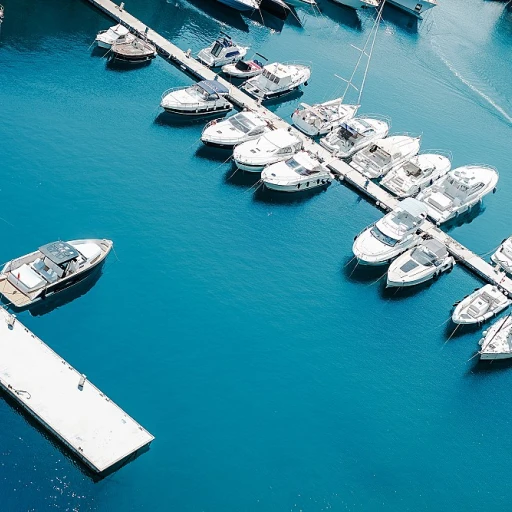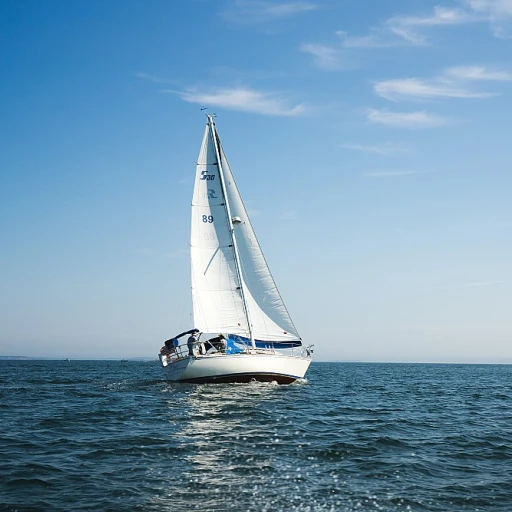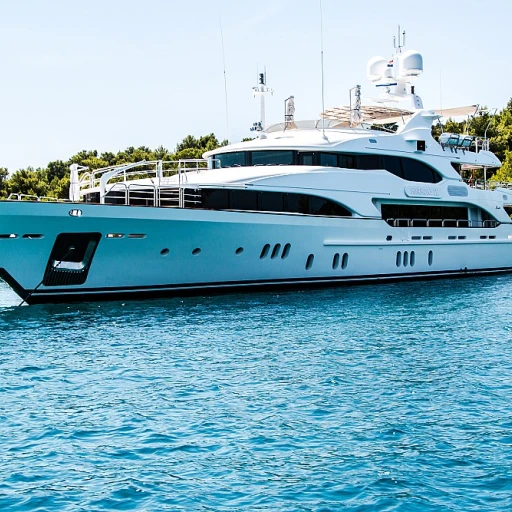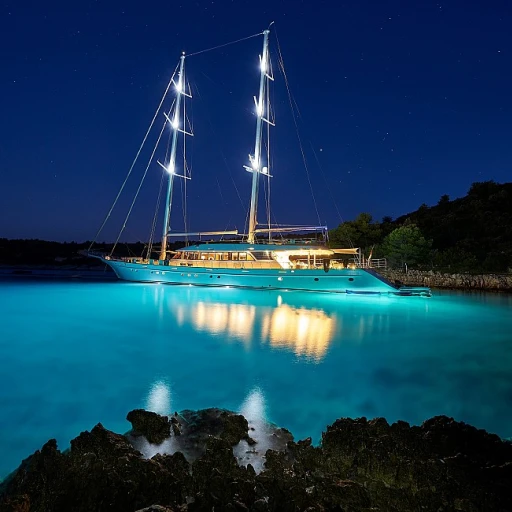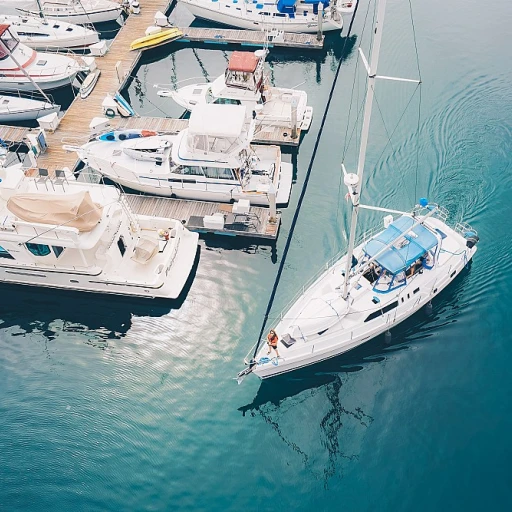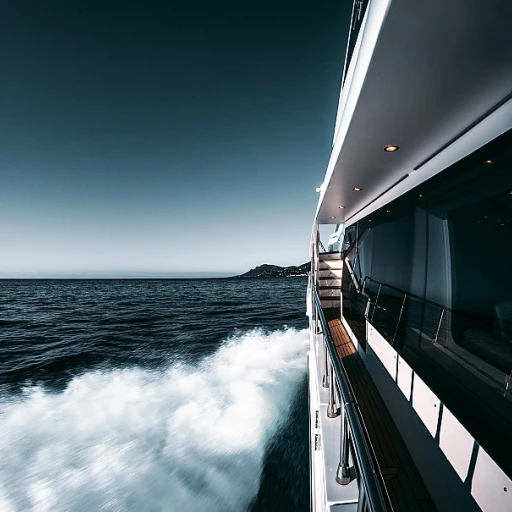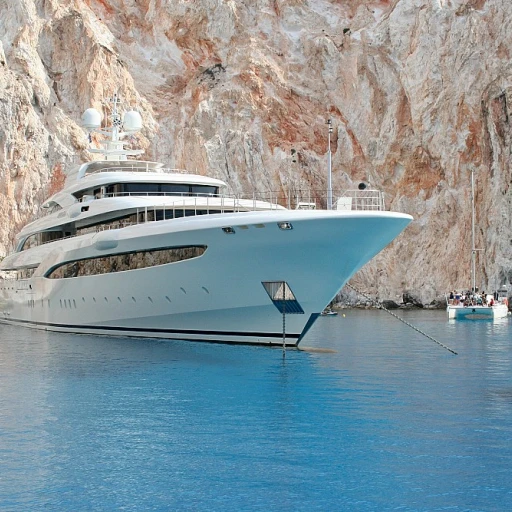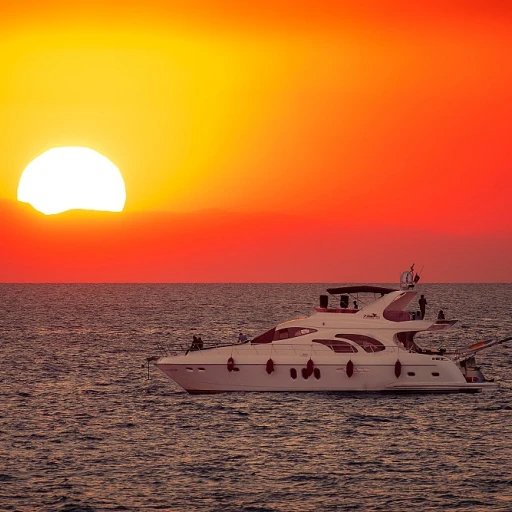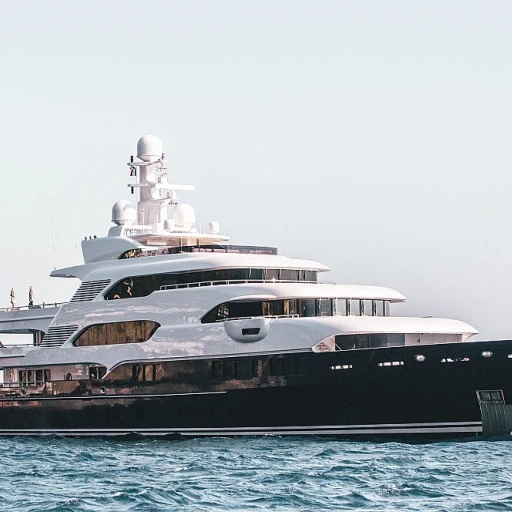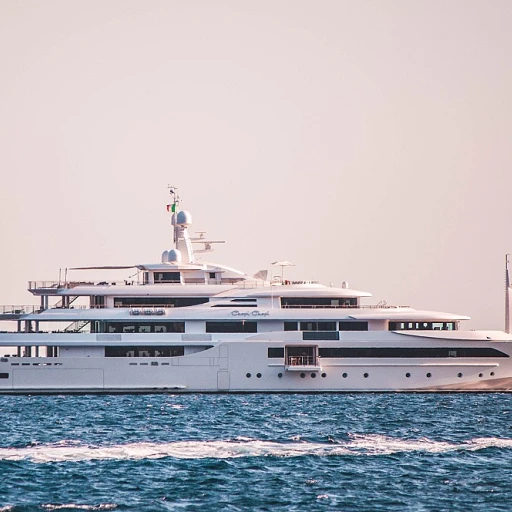
The vision behind Bill Gates' yacht Aqua
Bill Gates' inspirational vision for the Aqua yacht
When Bill Gates, co-founder of Microsoft, looked to the open sea to craft his next big venture, he sought more than just a fancy yacht; he envisioned a floating marvel of innovation and sustainability. Aqua, the so-called 'Bill Gates yacht,' represents just that. With its sleek design and state-of-the-art technology, insiders say Gates reportedly wanted to seamlessly blend luxury with an eco-conscious ethos. He aimed to set a new benchmark in the maritime industry, pushing boundaries and pioneering green hydrogen fuel.
A commitment to pioneering sustainable luxury
From the very beginning, Gates made it clear: Aqua would be a beacon for sustainable innovation. Removing conventional diesel engines, he opted for liquid hydrogen fuel cells. This choice could be seen as an effort to inspire broader adoption of green technology across the luxury yacht sector. Personalization perfection was key throughout the design process, emphasizing not only elegance but also innovative change.
Collaborators behind the dream vessel
The Aqua's creation isn’t just Gates' brainchild. Collaborating with renowned yacht designer Sander Sinot, known for his groundbreaking Sinot Yacht Design firm, Gates tapped into top-tier expertise. Additionally, the project saw contributions from the respected Feadship yard, particularly its Royal Van Lent division, heralded for their immaculate craftsmanship and rigorous standards. Even Jan-Bart Verkuyl, CEO of Feadship, played a notable role in bringing Aqua to fruition.
Marrying luxury, comfort, and ethics
The Aqua isn't just about environmental commitment. It also stands as the epitome of luxury. Imagine elegant cabins, expansive unoccupied guest spaces that double as plush relaxation havens, and state-of-the-art amenities including a Jacuzzi and spacious sun deck. Every inch of Aqua reflects Gates' dedication to more than just comfort; it’s about redefining what a super yacht can be while respecting the planet.
Innovative design and features of Aqua
State-of-the-art innovation in yacht design
The Aqua superyacht is nothing short of a masterpiece, combining cutting-edge technology with unparalleled luxury. Leading the design is Sinot Yacht Design, a name synonymous with revolutionary yacht creations. Sander Sinot, the visionary behind this project, ensured that Aqua embodies the very essence of opulence while pushing boundaries in yacht innovation.
One of the most striking features of Aqua is its hydrogen fuel cells. These cells are not just environmentally friendly; they are powerful enough to maintain the yacht's lavish amenities. From the expansive living spaces to the meticulously designed air conditioning and heat recovery systems, every aspect of Aqua reflects a commitment to sustainability and high performance.
Harnessing hydrogen: sustainability at its core
Thanks to its hydrogen fuel cells, Aqua is a pioneering example of how superyachts can integrate green technology. The fuel cells work by converting hydrogen into electricity, producing only water and heat as byproducts. This means Aqua has a minimal environmental footprint, a primary goal for Bill Gates, the tech magnate known for his dedication to tackling climate change. Jan-Bart Verkuyl, CEO of Feadship's Royal Van Lent, has emphasized the importance of green hydrogen in shaping the future of yacht propulsion.
Aqua is one of the first large-scale, private yachts to adopt this groundbreaking technology. The yacht stores its hydrogen in liquid form at extremely low temperatures, offering a practical and efficient way to fuel long voyages. This innovation has set a new benchmark in the industry, showing that luxury and sustainability can indeed go hand in hand.
Luxury redefined with Feadship
The Aqua project wouldn't have been possible without Feadship, a prestigious yacht-building company renowned for its handcrafted superyachts. Mike Lynch, a notable figure in the yachting world, highlighted how Aqua's design leverages Feadship's rich heritage in bespoke yacht construction. The collaboration with Sinot Yacht Design has resulted in a vessel where advanced technology and posh aesthetics coexist effortlessly.
Feadship's involvement extends beyond building the yacht; they are integral to its ongoing performance and maintenance. The company's expertise ensures that Aqua remains a pinnacle of innovation and luxury, embodying Bill Gates' vision of future-oriented yachting.
Curious about how yacht interiors are evolving to enhance exclusive lifestyles? Discover more here.
Hydrogen fuel cells: powering the future
Fuel cells: powering the future of luxury yachts
Bill Gates' yacht Aqua isn't just any superyacht; it's a game-changer, thanks mainly to its groundbreaking use of hydrogen fuel cells as its primary power source. The genius behind this lies in Aqua's reliance on hydrogen, which has been touted as the future of clean energy for maritime vessels. Research by the International Maritime Organization (IMO) indicates that switching to hydrogen could reduce greenhouse gas emissions by up to 70% in the shipping industry.How Aqua operates with hydrogen fuel cells
Utilizing hydrogen fuel cells means Aqua produces zero carbon emissions. It runs on liquid hydrogen stored in two 28-ton vacuum-sealed tanks at -423 degrees Fahrenheit. When hydrogen passes through the fuel cells, it combines with oxygen from the air to generate electricity, leaving water as the only byproduct. This energy powers everything on board, from propulsion to air conditioning and heating unoccupied guest spaces. Sander Sinot, the visionary behind Sinot Yacht Design, was pivotal in integrating these fuel cell systems into Aqua. In an interview, Sinot stated, "Our aim was to bring the future of sustainable luxury to the present."Key advantages of hydrogen for maritime applications
Hydrogen power offers numerous advantages for yachts and shipping. Besides its zero-emission credentials, hydrogen fuel cells are more efficient than traditional combustion engines and boast longer operational lives. Mike Lynch from HP, an advocate for renewable energy in the maritime industry, notes, "Hydrogen fuel cells exemplify how luxury and sustainability can coexist beautifully."Feadship's collaboration with Aqua
Regarding the technical prowess needed for such a revolutionary project, the renowned Dutch shipyard Feadship played an instrumental role. Feadship’s deep-rooted experience in pioneering environmentally friendly technologies lent invaluable expertise to the Aqua project. “Collaborating with Sinot Yacht Design and the Gates team allowed us to push the boundaries of yacht construction,” said Jan-Bart Verkuyl, CEO of Royal Van Lent, a division of Feadship. The yacht's completion marked a significant milestone for both Feadship and the maritime industry at large. For more on how historic advancements have paved the way for modern luxury sailing, check out this eye-opening unveiling elegance on waves piece.Feadship's involvement in the Aqua project
Feadship: masters of the Aqua project
Feadship, recognized globally as one of the world’s leading yacht builders, has played a pivotal role in the Aqua project. This illustrious Dutch shipyard has a heritage stretching back to 1849 and is renowned for crafting bespoke, luxury yachts of unparalleled quality and innovation. Their partnership with Sinot Yacht Design on this project is a testament to their commitment to pushing the boundaries of yacht design and engineering.
Feadship's involvement in Aqua isn't just about building another luxury yacht; it's about revolutionizing maritime design by integrating futuristic, sustainable technology seamlessly with luxury. The Aqua, with its groundbreaking hydrogen fuel cell technology, epitomizes this blend. Feadship's expertise was crucial in ensuring that the design and engineering feats proposed by Sinot were brought to life without compromising on performance, safety, or luxury.
Jan-Bart Verkuyl, CEO of Royal Van Lent (a faction of Feadship), has been instrumental in driving the project forward. Verkuyl's vision for Feadship aligns with the innovative ethos of Aqua, aiming to lead the industry towards greener alternatives without sacrificing the prestige and comfort of traditional luxury yachts. “We are proud to lead the charge in this new era of yachting, where sustainability meets the luxury our clients expect,” he remarked in a recent interview.
The collaboration also involved close work with MTU Friedrichshafen, experts in marine propulsion systems, to develop the yacht's high-performance hydrogen fuel cells. This synergy between Feadship, Sinot, and MTU highlights the collaborative nature of modern engineering challenges, combining expertise from multiple fields to achieve groundbreaking results.
Moreover, Feadship's attention to detail and commitment to quality assurance ensured that every aspect of Aqua met the highest standards. This includes not only the innovative propulsion system but also the luxurious interior, the waste heat recovery system, and the overall aesthetic appeal. From the spacious staterooms to the advanced air conditioning and heating systems, every element of Aqua exudes sophistication and technical prowess.
Feadship's role in bringing Aqua to life is more than that of a traditional shipbuilder; they are innovators, collaborators, and leaders in sustainability. This project doesn’t just set a new benchmark for luxury yachts; it paves the way for future developments in eco-friendly marine engineering.
Sustainability and environmental impact
Sustainability at the heart of Aqua
Bill Gates' yacht Aqua represents a pivotal moment in marine technology focusing on sustainability. Gates, known for his innovative approaches through Microsoft, is bringing his visionary excellence to the yachting field as well. Incorporating hydrogen fuel cells for propulsion, the Aqua yacht is designed to be a game-changer in reducing marine environmental impact.
The Aqua isn’t just powered by traditional means but utilizes liquid hydrogen stored in vacuum-sealed tanks at -253°C. These fuel cells produce electricity by mixing hydrogen with oxygen, only emitting water as a byproduct. The result is a virtually zero-emission yacht, a breakthrough in clean propulsion technology.
Pioneering green hydrogen technologies
The Aqua yacht is more than a floating luxury palace. According to The Guardian, Gates likely chose green hydrogen technology for its immense potential to reduce carbon footprints, aligned with his commitment to tackling climate change. Unlike conventional yachts that run on diesel, Aqua's innovation might set a benchmark in the maritime industry.
Sander Sinot, the visionary behind Sinot Yacht Design, emphasizes the importance of integrating sustainability in luxury. Even the yacht's heating, unoccupied guest spaces, and air conditioning systems have been optimized to improve the energy efficiency by harnessing waste heat recovery systems, a distinct move towards sustainability within the yachting sector.
Waste heat recovery and energy efficiency
Aqua’s design ensures that energy is not wasted. For example, the waste heat recovered from the fuel cells is utilized to power the yacht’s systems, such as air conditioning and other onboard amenities. This kind of circular energy usage significantly minimizes the environmental impact, making Aqua a pioneer in sustainable luxury yachting.
Setting a new standard in eco-luxury
With Aqua, Bill Gates not only sets new standards in yacht luxury but also in sustainability. As noted by experts like Jamie Edmiston, CEO of Edmiston & Company, “Aqua will inspire the next generation of superyachts to adopt more sustainable technologies.”
Bill Gates’ participation in projects like Aqua sends a clear message to the luxury yacht industry. It's not just about lavish design and comfort; it's about integrating eco-friendly technologies to address the pressing issues of climate change.
The Aqua's role at the forefront of green yachting technology is a call to action for the industry, pushing other yacht builders to innovate and embrace sustainable solutions. The hope is that other superyachts will follow suit, spearheading a shift towards hydrogen powered superyachts and further reducing our environmental footprint.
Luxury and comfort on board Aqua
Unmatched elegance and comfort
When it comes to luxury and comfort, the Aqua yacht is truly in a league of its own. One striking feature that stands out is the unparalleled design by the esteemed Sinot Yacht Design, offering an array of amenities ensuring an unforgettable experience.
The yacht boasts expansive unoccupied guest spaces, enabling a sense of tranquility even when accommodating multiple guests. Rooms have been designed to seamlessly blend opulence with functionality. For beauty and relaxation, onboard extensions like a Jacuzzi take luxury to another level, making it an ideal retreat for owners and guests alike.
Redefining luxury through technology
Equipped to meet the highest standards, Aqua integrates advanced technologies for air conditioning and heating. These systems are designed by the renowned Mike Lynch, ensuring a perfect ambient temperature. The inclusion of a waste heat recovery system ensures the yacht remains efficient while luxurious.
Exquisite touchpoints enhancing the Aqua experience
Guest comfort on Aqua got a boost thanks to the superb work of Feadship and their unwavering attention to each detail. Jan Bart Verkuyl and his team have spared no effort in ensuring that Aqua's finish is flawless. The room decor features sumptuous materials sourced globally. Every bedroom is outfitted with plush bedding that envelopes you in comfort and serenity, encouraging restful sleep on the high seas.
Lauded yet controversial aspects
The yacht has not been without its fair share of controversies. Reports emerged revealing the staggering sale price, bolstering its status as a superyacht but also drawing criticism about extravagance. Meanwhile, Bill Gates' reported association with the yacht has intensified the media spotlight, further giving rise to discussions surrounding the billionaire's personal green initiatives.
In conclusion, the Aqua yacht does not merely stand as a symbol of Bill Gates' lavish lifestyle. It invites guests into a sanctum of comfort and luxury, seamlessly integrated with cutting-edge technology and sustainability efforts. It’s more than just remarkable craftsmanship; it’s living proof of how the superyacht industry can balance opulence with eco-conscious considerations and technological marvels.
The role of key figures in the Aqua project
Influential figures leading the Aqua project
The creation of Aqua, the groundbreaking superyacht commissioned by Bill Gates, has been a collaborative effort involving some of the most esteemed individuals in the yacht industry. One of the key figures is Sander Sinot, founder of Sinot Yacht Design, who is widely recognized for his innovative and sustainable yacht designs. Sinot's vision for Aqua was to marry luxury with cutting-edge green technology, ensuring that the yacht would not only be opulent but also eco-friendly.
Sinot worked closely with Feadship, a renowned Dutch shipbuilding company with a reputation for crafting some of the finest superyachts in the world. Jan-Bart Verkuyl, CEO of Feadship's Royal Van Lent shipyard, played a pivotal role in overseeing the construction of Aqua, ensuring that every detail met the highest standards of quality and sustainability. The partnership between Sinot and Feadship resulted in a yacht that is not only a marvel of modern engineering but also a benchmark for the future of luxury yachts.
Another notable figure in the Aqua project is Mike Lynch, a renowned engineer and entrepreneur who has been at the forefront of developing hydrogen fuel cell technology. Lynch's expertise was instrumental in designing Aqua's state-of-the-art hydrogen fuel cells, which allow the yacht to operate with zero emissions. This collaboration has positioned Aqua as a trailblazer in environmentally sustainable yachting.
Bill Gates, the founder of Microsoft, has long been an advocate for sustainable innovation, and his involvement in the Aqua project is no exception. Gates reportedly envisioned a superyacht that could lead the way in green technology while offering unparalleled luxury and comfort. His dedication to the project has set a new standard in the yachting industry, inspiring other yacht owners and builders to consider sustainable alternatives.
Among the many key contributors, Angela Bacares, a prominent interior designer, also deserves mention. Her role was to ensure that Aqua's interiors reflect the same level of luxury and innovation as its exterior design and technological features. Bacares' meticulous attention to detail has resulted in a sumptuous living space that enhances the yacht's overall appeal.
Market impact and future trends
Market impact and future trends of Aquas
Bill Gates reportedly entering the yacht market with the Aqua, a hydrogen powered superyacht developed by Sinot Yacht Design, has already caused ripples. The announcement itself showcased the future of yacht propulsion systems and set a benchmark in luxury and sustainability. By choosing the hydrogen fuels route, Gates founder of Microsoft made a statement not just about personal luxury but also about environmental responsibility, marking a significant shift in industry trends.
The Aqua, with its innovative hydrogen fuel cells, introduces a green hydrogen-based propulsion system that stands out in a market long dominated by diesel engines. This system cuts down on carbon emissions and reduces the environmental footprint of super yachts, encouraging more sustainable practices. A study by the International Maritime Organization supports that adopting green hydrogen solutions could drastically decrease maritime pollution by up to 50% by 2050.
Experts like Jan-Bart Verkuyl from Feadship, one of the key collaborators on the water yacht built project, stress that the Aqua sets a new standard. In an interview with The BBC, Verkuyl emphasized, "The unique features of Aqua, such as its liquid hydrogen tanks and air conditioning heating systems, showcase what's possible when you combine innovation with luxury. This represents a significant turning point for future yacht designs."
As superyacht enthusiasts and industry players keep a close eye on the Gates' Aqua, they're also seeing a broader trend towards environmentally friendly initiatives within the maritime sector. Super yacht owners are increasingly interested in yachts powered by alternative fuels such as methanol hydrogen and exploring options like waste heat recovery systems and fuel cell systems.
Market analysts predict that the integration of hydrogen fuel cells could potentially redefine the yachting sector, making these alternative fuels a standard choice. According to Mike Lynch from Yachts International, "The demand for sustainable luxury is driving many high-net-worth individuals to reconsider their options. Hydrogen fuel cells aren't just a statement; they're the future of yachting."
The impact of Bill Gates' venture into the superyacht market extends beyond just a luxurious, hydrogen-fueled vessel. It's about setting new expectations and inspiring subsequent projects. As touched upon in earlier topics, the Aqua project, with the help of renowned builders like Feadship and designers like Sander Sinot, plays a pivotal role in steering the market towards a sustainable future.


